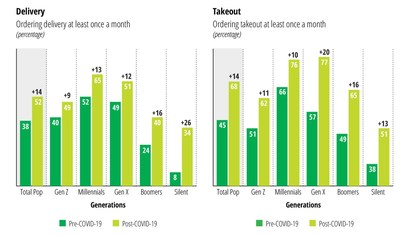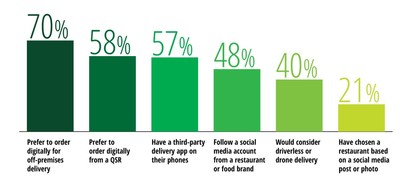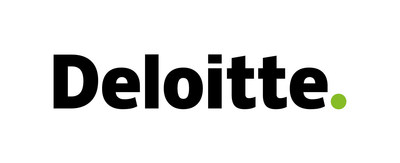NEW YORK, Oct. 26, 2020 /PRNewswire/ --

Key takeaways
- Consumers demand efficiency now more than ever; nearly two-thirds (62%) of respondents cite convenience as the main reason they visit a restaurant.
- Since COVID-19, delivery and takeout orders have continued to increase, up 14%, to 68% and 52%, respectively, for consumers ordering once a month or more, driving restaurants to rethink their physical footprints.
- Nearly a quarter of consumers (23%) say their more frequent use of takeout and delivery will be permanent.
- Consumers demand a frictionless digital experience, as 70% of respondents prefer to place their delivery orders online.
- As safety concerns continue, 71% of consumers request contactless delivery from restaurants.
Why this matters
COVID-19 forced mass shutdowns of restaurant dining rooms, causing the industry to consider new options for dining out at home and modifying store footprints to better serve the increased need for delivery and take-out orders. According to Deloitte's new report, "The Restaurant of the Future Arrives Ahead of Schedule – Time to Get on Board," as consumers place a premium on convenience and favor digital connections, a new focus on safety has amplified those demands and accelerated restaurant roadmaps for innovation.
This study is based on two surveys of restaurant customers from December 2019 and June 2020, as well as interviews with executives from quick service restaurants (QSR), fast casual and casual dining brands. It examines new consumer demands amid the pandemic and how the restaurant industry is rebounding and preparing for long-term growth.
Convenience is the main ingredient driving restaurant demand
Now more than ever, consumers want to get their food and go, quickly. In fact, during interviews some QSR restaurant executives reported that drive-through volume, once 20% of their business, has increased to 90% since the COVID-19 outbreak. This increase in off-premises orders is not likely to change anytime soon, as almost half (46%) of consumers expect their dining habits to remain at current COVID-19 levels for the foreseeable future.
Millennials (ages 23 to 39) and Gen X (ages 40 to 55) are leading the way in placing delivery orders (65% and 61%, respectively for delivery, and 76% and 77%, respectively for takeout). And generally, they are willing to pay for that added convenience, so long as it meets their expectations. Consumers consider a $4 delivery fee, on average, to be fair for this level of convenience. However, they still expect their food to be ready in a timely fashion, as three-quarters of consumers (75%) consider 30 minutes or less a reasonable wait time. Only 1 in 5 (20%) consider it realistic to wait up to 45 minutes for their meal. Knowing the importance of minimal wait times, restaurants are exploring new and innovative ways to better serve customers. For example, almost two-thirds (62%) of customers are willing to pick up food from a location other than the restaurant itself, like a delivery hub. In addition, 44% of consumers would order delivery of uncooked meals they finish preparing at home.
Diners savor a cohesive digital experience
The limitations of dining out during COVID-19, combined with the continued demand for convenience is quickly accelerating the digital experience. In fact, while fast casual and casual diners both preferred interacting with cashiers prior to COVID-19, their preference for apps has significantly escalated. Among consumers surveyed:
- Seventy percent prefer to order digitally for off-premise delivery, and 58% prefer to order digitally from a QSR. Further, consumers are willing to pay an average of 14% more for this convenience.
- More than half (57%) have a third-party delivery app on their phones.
Consumers' preference for online ordering has many restaurants worried about the consistency of their brand experience, when third-party vendors are used, causing them to consider taking back ownership of the experience. Not only does complete ownership of the ordering and delivery experience help to maintain control of the brand, it also gives the restaurant direct access to customer marketing and data to inform digital and loyalty programs. In the meantime, until restaurants can secure total ownership, social media presents a strong opportunity for restaurants to build brand loyalty, interact with diners and drive growth as 48% of consumers follow a restaurant or food brand's account, and 21% have selected a restaurant based on a social media post.
As restaurants look to appeal to the digital experience, they may leverage technologies like driverless or drone delivery, which 40% of consumers would consider for delivery of their food. Additionally, ghost kitchens are rising in popularity as more than half (56%) are willing to order from a restaurant without a customer-facing storefront. Regardless of the channel, restaurants will have to present a cohesive but contextual digital experience to keep customers engaged.
Key quote
"COVID-19 has challenged restaurants by temporarily closing dining rooms, but it has also provided the industry the chance to seek out new opportunities to engage customers. Even before the pandemic, consumers were increasing their demands for convenience and digital engagement. Now more than ever, the ball is in each restaurant's court. What they do to respond will shape the future of each brand. Restaurants that emerge from this unplanned inflection point in the industry's history will be set up to provide a new standard in customer convenience, responsiveness, and safety that can pay off long after the tumult of this pandemic is over."
- Jean Chick, principal, Deloitte Consulting LLP, and U.S. restaurant and food service leader
In the wake of COVID-19, consumers want safety protocols to be a show and tell
The pandemic has changed the rhythm of everyday life, including meals. Whether opting for dine in service, take out or delivery, cleanliness and safety are top priorities for consumers. As a result, 87% of consumers expect surfaces be cleaned after each use. However, it's not enough to know the safety precautions restaurants are taking: 85% of consumers want to actually see the cleaning take place. Protocols like wearing of gloves by employees, constant cleaning of tables and other common surfaces and the use of plexiglass shields don't just promote safety and cleanliness — they signal to the diner how seriously management takes that responsibility. Four out of five people said they are more likely to patronize a restaurant if they knew what steps it was taking to enhance cleanliness, food safety or guest safety and, as a result, would be willing to pay an average of 10% more. This puts a premium on communication as frequent diners are more likely (56%) to trust a brand's website than an occasional customer (43%).
Connect with us on Twitter at @DeloitteCB or on LinkedIn @JeanChick.
About Deloitte
Deloitte provides industry-leading audit, consulting, tax and advisory services to many of the world's most admired brands, including nearly 90% of the Fortune 500® and more than 7,000 private companies. Our people work across the industry sectors that drive and shape today's marketplace — delivering measurable and lasting results that help reinforce public trust in our capital markets, inspire clients to see challenges as opportunities to transform and thrive, and help lead the way toward a stronger economy and a healthy society. Deloitte is proud to be part of the largest global professional services network serving our clients in the markets that are most important to them. Now celebrating 175 years of service, our network of member firms spans more than 150 countries and territories. Learn how Deloitte's more than 312,000 people worldwide make an impact that matters at www.deloitte.com.
Deloitte refers to one or more of Deloitte Touche Tohmatsu Limited, a UK private company limited by guarantee ("DTTL"), its network of member firms, and their related entities. DTTL and each of its member firms are legally separate and independent entities. DTTL (also referred to as "Deloitte Global") does not provide services to clients. In the United States, Deloitte refers to one or more of the US member firms of DTTL, their related entities that operate using the "Deloitte" name in the United States and their respective affiliates. Certain services may not be available to attest clients under the rules and regulations of public accounting. Please see www.deloitte.com/about to learn more about our global network of member firms.


![]() View original content to download multimedia:http://www.prnewswire.com/news-releases/deloitte-the-restaurant-of-the-future-arrives-ahead-of-schedule-301159056.html
View original content to download multimedia:http://www.prnewswire.com/news-releases/deloitte-the-restaurant-of-the-future-arrives-ahead-of-schedule-301159056.html
SOURCE Deloitte




















